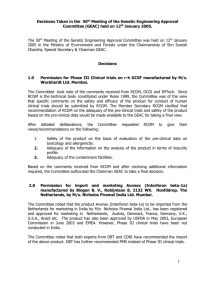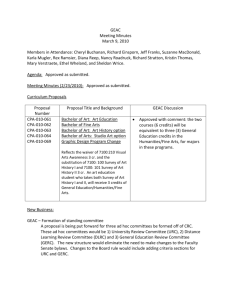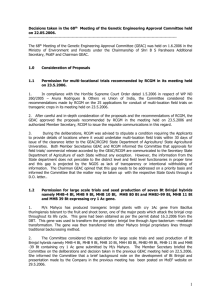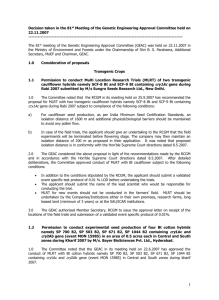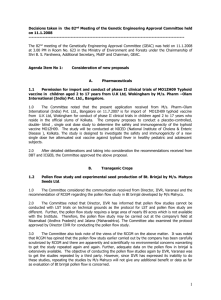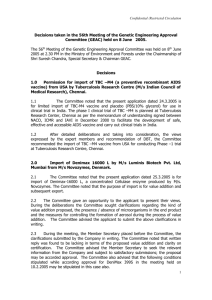Regulatory legislation and guidelines for recombinant drugs
advertisement
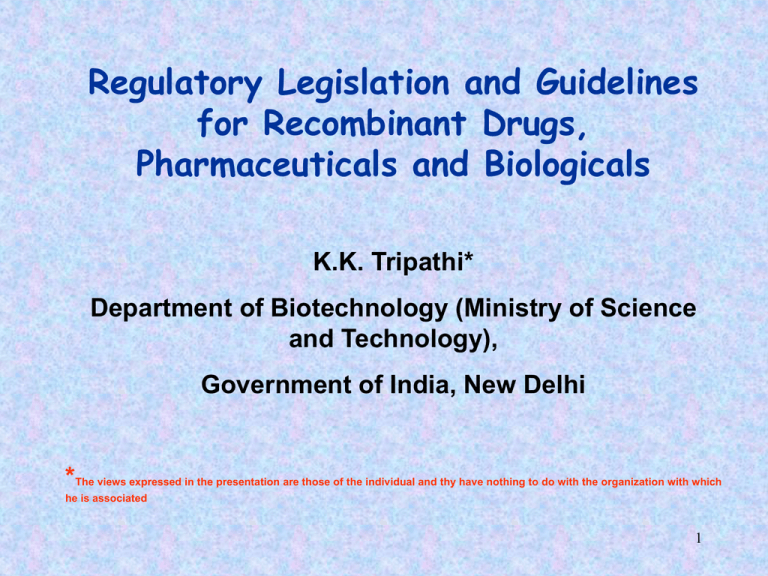
Regulatory Legislation and Guidelines for Recombinant Drugs, Pharmaceuticals and Biologicals K.K. Tripathi* Department of Biotechnology (Ministry of Science and Technology), Government of India, New Delhi *The views expressed in the presentation are those of the individual and thy have nothing to do with the organization with which he is associated 1 Biotech Industry and rDNA Research Indian Companies in modern biotechnology Over 900 companies operating in all sectors biotechnology, of Biopharmaceuticals- >49 Transgenic Crops/Seeds- >60 Industrial Products- 15 (Probiotics, Enzymes) Indian Institutions in modern Biotech Research Over 90 Institutions engaged in rDNA Research Public Funded Institutions- >57 Private Institutions (Teaching & Research)- >37 Universities- >115 2 Total number of organisations involved in rDNA Research- 256 A TYPICAL CASE OF STAKEHOLDERDS’ INTERACTION SHAPING THE FUTURE OF TRANSGENICS Central government - want to enforce EP Act through sate governments as per biosafety guidelines Politicians - want protection of public interests and safety of environment with punishment to guilty as per Law Public general – seeks information and are more concerned for future with benefits and risks of rDNA products Scientists - want to set an example by providing more products with modern biotech research Media – want report regularly and views of all without wrong interpretations Ihdustry - request to protect their investment and enforce law at the same time Consensus is building on to protect public interest, punish guilty and ensure maximum safety to environment with no 3 (relatively low) risk !!! The public should be viewed as a “partner” and a level of trust needs to be created. Developing this style will be a major challenge for business leaders as well as university/industry scientists and government regulators. The Public perception is most important in the success/failure of rDNA product and safety aspects to environment/humans/animals etc. 4 Why Regulations are Necessary for Using GMOs and Products Thereof? GMOs and and their products are to play important role including human and animal health care system, agriculture, industrial products, environment management Concurrently, there could be unintended hazards and risks from the use of GMOs and products thereof, if the new technology was not properly assessed before use A GMO can be safe but this can be unsafe too depending upon the trans-genes, the host organism and the environment where the GMO is being tested GMOs can be microorganisms, plants, and animals 5 6 GENETICALLY MODIFIED ORGANISMS (GMOs) AND r-DNA PRODUCTS GOVERNED BY Environment (Protection) Act, 1986; - Rules, 1989 of EPA Industries (Development & Regulation) Act, 1951 - New Industrial Policy & Procedures, 1991 - EXIM Policy Drugs & Cosmetics Act, 1940 - Rules 1945 Pharmaceutical Policy 2002 7 Indian EPA implementation structure for GMOs (1989 RULES) In order to contain possible hazards to environment from the release of GMOs, the Ministry of Environment and Forests has notified in December 1989, the “Rules for the manufacture, use, import, export and storage of hazardous Micro-organisms/ Genetically Engineered Organisms or Cells” under the Environment (Protection) Act (EPA)1986. 8 APPLICATIONS OF 1989 RULES Manufacture, import and storage of microorganisms and gene technological products Genetically engineered organisms/ microorganisms and cells and correspondingly to any substance and products and food stuffs, etc., of which such cells, organisms or tissues form part New gene technologies in addition hybridization and genetic engineering to cell 9 STATUTORY BODIES 1. The Recombinant DNA Advisory Committee (RDAC): 2. Institutional Biosafety Committee (IBSC) 3. Review Committee on Genetic Manipulation (RCGM) 4. Genetic Engineering Approval Committee (GEAC) 5. State Biotechnology Coordination Committee (SBCC) 6. District Level Committee (DLC) 10 INSTITUTIONAL BIOSAFETY COMMITTEE (IBSC) Constituted by an occupier or any person including R&D institutions handling GMOs Comprises Head of Institution, scientist doing rDNA work, medical expert and DBT nominee Assists the occupier or any person including R&D institution prepare an emergency plan as per guidelines of RCGM Copies of emergency plan to be made available to District Level Committee/State Biotechnology Coordination Committee and the Genetic Engineering Approval Committee (GEAC) 11 REVIEW COMMITTEE ON GENETIC MANIPULATION (RCGM) RCGM is functioning in the Department of Biotechnology. Its functions are: To review the reports in all approved/ongoing projects involving high risk category and controlled field experiments research in four areas namely human and animal healthcare, agriculture, industry and environmental management. To visit site of experimental facilities periodically where projects with biohazard potential are being pursued and also at a time prior to the commencement of the activity to ensure that adequate safety measures are taken as per the guidelines. To issue clearance for import/export of etiologic agents and vectors, germplasms, organelle, etc. needed for experimental work/training and research. 12 GENETIC ENGINEERING APPROVAL COMMITTEE (GEAC) The GEAC is functioning under the Ministry of Environment and Forests to examine and issue the clearance from the view point of environmental safety on a case by case basis for: Activities involving large scale use of hazardous micro-organisms and recombinants in research and industrial production from environmental angle. Proposals relating to the release of genetically engineered organisms and products into the environment including experimental field trials. 13 IN ORDER TO EVALUATE PROPOSALS, DBT HAS ISSUED FOLLOWING GUIDELINES: Recombinant DNA Safety Guidelines, 1990 Recombinant DNA Safety Guidelines and Regulations, 1994 Revised Guidelines for Safety in Biotechnology, 1994 Revised Guidelines for Research in Transgenic Plants, 1998 Guidelines for generating pre-clinical and clinical data for rDNA vaccines, diagnostics and other Biologicals, 1999. Revision of Guidelines is a continuous process 14 General approval procedures for recombinant products Proposal Institutional Biosafety Committee with DBT Nominee RCGM’s approvals Based on the pre-clinical trial data, RCGM conveys its recommendations to the applicant and copy to the DCG(I) and to GEAC RDAC approves the protocol and recommends for conducting human clinical trials IBSC examines the human clinical trial data and sends it for RCGM and DCG (I) for Recommendation to GEAC for environmental release GEAC approval for Environmental Release 15 The applicant is to follow the provisions of the Drugs Act for commercial release of the product. This shall include inspection of the production facilities, according temporary license to produce trials batches, sending products from 5 trial batches to CRI, Kasauli or CDL, Kolkata, receiving the test report by DCG (I) and finally granting approval to manufacture and marketing the product. Both DCG (I) and GEAC can impose conditions of surveillance on the product during marketing. Marketing under EPA can be for a period of two to four years initially and this can be renewed on the basis of an application. Post-market surveillance data may be required to be generated and submitted to DCG (I) and GEAC by the applicants 16 A Biosafety System Guidelines People Biosafety Review Process 17 SUGGESTED MMODIFICATION IN THE STEPS Proposal Institutional Biosafety Committee with DBT Nominee RCGM’s approvals Based on the pre-clinical data, RCGM conveys its recommendations to the applicant (copy to the DCG (I) for further n.a. and to GEAC for information) RDAC/DCG(I) approves the protocol and recommends for conducting human clinical trials; DCG(I) Examines the Human Clinical Trials data and Recommends to GEAC directly GEAC approval for Environmental/Commercial Release 18 The Mashelkar Committee Inter-Ministerial Committee setup by The Ministry of Environment & Forests New Delhi Report on Recombinant Pharma Sector (Discussed on January 23, 2005) 19 Recommendations of the Task Force on r-Pharma a. The step-wise regulatory procedures/protocols for Regulation of Recombinant Pharma Products derived from Living Modified Organisms (LMOs). b. Time lines for approvals. c. Recommendations on other Linked issues. d. Inter-ministerial Standing Committee on Biotechnology Regulation. e. Proposed independent institutional mechanism - National Biotechnology RegulatoryAuthority/Commission. 20 The step-wise regulatory procedures /protocols for five categories Protocol-I:Indigenous product development, manufacture and marketing of pharmaceutical products derived from LMOs but the end product is not a LMO. Protocol-II:Indigenous product development, manufacture and marketing pharmaceutical products where the end product is a LMO. Protocol-III:Import and marketing of LMOs as Drugs/Pharmaceuticals in finished formulations where endproduct is a LMO. Protocol-IV:Import and marketing of LMOs as Drugs/Pharmaceuticals in bulk for making finished formulation where end product is a LMO. Protocol-V:Import and marketing of products derived from LMOs as Drugs/Pharmaceuticals and bought in bulk and/or finished formulations where end product is not a LMO. 21 Protocol – I Indigenous product development derived from LMOS but end product not a LMO. Risk Group III and above Applicant Risk Group I & II IBSC IBSC RCGM approves pre-clinical trials RCGM approves pre-clinical trials Pre-clinical trial conducted Pre-clinical trial conducted RCGM recommends human CT to DCGI and forwards views on containment facilities to GEAC RCGM recommends human CT DCGI approves human CT Human CT conducted DCGI approves market authorization under Drugs and Cosmetic Rules based on the clinical trials data DCGI - Post release monitoring DCGI approves human CT GEAC examines environmental risk v/s benefit based on the information on containment facilities and data on clinical trials Environmental Clearance Rule1989 Human CT conducted DCGI approves market authorization under Drugs and Cosmetic Rules based on the clinical trials data DCGI - Post release monitoring 22 Protocol – I Indigenous product development derived from LMOs but end product is not a LMO. • As per the new recommendations, (i) GEAC has no role in the regulation of LMOs falling under Risk Group 1 & II; (ii) GEAC has no role in the approval of Phase-III clinical trials for risk group III & above; • Amendment of Rule 1989 is not required in respect of (i) as MoEF may exercise the provisions of exemption under rule 20 which states ‘The Ministry of Environment and Forests shall, wherever necessary, exempt an occupier handling a particular microorganism/genetically engineered organism from rule 7-11” . Accordingly LMOs falling under risk Group 1 & II may be exempted from GEAC clearance. • Further, the specific provision stipulating prior approval of GEAC for human clinical trials in recombinant pharma products are contained in the 1999 DBT Guidelines for Generating Pre-Clinical Data for r-DNA Based Vaccines, Diagnostics and other Biologicals. Since there is no role of the GEAC for Phase-III clinical trials in case of therapeutic proteins, the DBT guidelines need to be suitably amended. • Under Protocol I there is no change in the role of RCGM and DCGI. 23 Indigenous Product development where end Product is a LMO Protocol – II Applicant IBSC RCGM (approves pre- clinical trials) Pre-clinical trials conducted RCGM (evaluates toxicity and allergenicity data and Containment facilities and recommends CT) DCGI GEAC (approves Human CT and protocols) (recommends Human CT) A A 24 A Protocol – II Contd. HUMAN CT conducted DCGI (approves Market Authorization under Drugs & Cosmetics Rules based on clinical trials data) GEAC (examines environmental risk versus benefits and accords approval for environmental release under Rule 1989) DCGI (Post Release Monitoring) 25 Protocol – III Import and marketing of LMOs as drugs in finished formulations Applicant GEAC (examines data generated in the Country of origin and other countries where the product has been tested and accords ‘In Principle’ approval for import and conduct of clinical trials. GEAC recommends to DCGI) DCGI (approves Human CT and protocols) HUMAN CT conducted DCGI (approves Market Authorization under Drugs & Cosmetics Rules based on clinical trials data) DCGI (Post Release Monitoring) GEAC (examines environmental risk versus benefits and accords approval for environmental release under Rule 1989). 26 Protocol – IV Import of LMOs as drugs in bulk for making finished formulations. Applicant GEAC (examines data generated in the Country of origin and other countries where the product has been tested and accords “in principal” approval for limited import for conduct of clinical trials, GEAC informs DCGI and directs the applicant to setup IBSC) IBSC RCGM (approves activity, recommends to DCGI for clinical trials and forward views to GEAC on containment facilities) DCGI GEAC (approves Human CT and protocols) (recommends Human CT) A A 27 Protocol – IV Contd. A HUMAN CT conducted DCGI (approves Market Authorization under Drugs & Cosmetics Rules based on clinical trials data) DCGI (Post Release Monitoring) GEAC (examines environmental risk versus benefits and accords approval for environmental release under Rule 1989) 28 Protocol – V Import and marketing of products derived from LMOs as Drugs and bought in bulk and/or finished formulations. Applicant DCGI (Examination of complete dossier including human clinical trials protocols and trials if conducted and to accord approval for Human CT and protocols after obtaining the comments of RCGM) HUMAN CT conducted DCGI (approves Market Authorization under Drugs & Cosmetics Rules based on clinical trials data) DCGI (Post Release Monitoring) 29 Protocol – V Import and marketing of products derived from LMOs as Drugs and bought in bulk and/or finished formulations. • As per the new recommendations, (i) GEAC has no role in the import of recombinant therapeutic proteins as drugs. (ii) RCGM to give their comments on the import proposal to DCGI. • Amendment of Rule 1989 is not required to accommodate the proposed change as we MoEF may exercise the provisions of exemption under rule 20 which states ‘The Ministry of Environment and Forests shall, wherever necessary, exempt an occupier handling a particular microorganism /genetically engineered organism from rule 7-11”. Accordingly the import of recombinant drugs where the end product is not a LMO may be exempted from GEAC clearance. • DCGI is of the view that in Protocol V the word “after obtaining the views of RCGM” to be deleted. They have suggested that RCGM function to be combined with RDAC under the office of DCGI. This would require a major amendment to Rules 1989. 30 Time lines for approvals RCGM approval for pre-clinical animal studies: 45 days RDAC approval for Human Clinical Trials protocol: 45 days RDAC (DCGI) examination of trial data and approval:Case specific Simultaneous DCGI & GEAC* approvals: 45 days *GEAC approval procedure will be compliant with the ‘Good Practices in Environmental Regulation adopted by MoEF. 31 Other Recommendations The products emanating from mono-clonals derived from rDNA technology in the form of therapeutic proteins/drugs would attract the provisions of Rule 1989 of EPA, and can be treated under Protocol I as Risk Category I & II. If there is a change in the host organism or expression construct, fresh permission will be required to be sought from RCGM for the change by providing adequate data on bio-equivalence. If the data is found to be inadequate then RCGM may prescribe limited pre-clinical and/or clinical studies to be conducted to establish bio-equivalence. This would also be applicable to finished imported products intended for marketing. 32 Other Recommendations (contd)-- No imported recombinant pharma product should be allowed to be introduced in the Indian market without adequate evaluation of clinical trial data or clinical evaluation in the Country. The Task Force recommends that the efficacy and safety of the imported product should be evaluated for its efficacy on the Indian population before issue of market authorization. For import of GMO / LMO for research/contract manufacturing or similar service, where the product (which is not an LMO) is to be exported out of India, a procedure should be laid down so that the companies can explore opportunities for this business while the safety aspect is also adequately addressed. A suggested procedure is: IBSC to examine proposal and recommend to RCGM; RCGM to approve if within Risk Group I and II. If organism is of Risk Group III or above, GEAC permission will be required. DCG(I) need not play any role. 33 Other Recommendations (contd)--- Enzymes /industrial products from GMOs would attract the provisions of Rule 1989 of EPA. In such cases, RCGM may be authorized to approve such proposals under intimation to GEAC. The expertise in the various regulatory agencies under Rules 1989 of EPA should be further strengthened. There is a need for creation of an independent inspection facility to audit the manufacturing and containment facilities set up by the applicants involved in the production of recombinant drugs. This would also ensure acceptability of the Indian r-DNA pharmaceutical products in the global market. Since there is no single agency with adequate field level support system to carry out an independent inspection, the Task Force recommends that the Government may set up a separate agency for this purpose. On the issue of seeking approvals of PPA/DCGI/GEAC under Rules 1989 of EPA and PQO by Customs Authorities on the imports of microorganisms, GMOs/ LMOs for R&D purpose it is suggested that the earlier practice of permitting the import with the approval of RCGM should continue and PPA/DCGI to issue instructions to Custom Authorities to clear the consignment based on RCGM 34 approval. Inter-ministerial Standing Committee on Biotechnology Regulation Constitution of a standing inter-ministerial committee to redress and look into various regulatory aspects and make issue-based recommendations on case-by-case basis. Prior to any deviation from the proposed regulatory mechanism, which when comes in vogue, the views of this inter-ministerial committee should be obtained in the first instance. The suggested composition of the committee is as follows: Chairman -To be an Eminent Scientist Chairman, GEAC -Member Chairman, RCGM -Member Member-Secretary, GEAC -Member Member-Secretary, RCGM -Member Joint Secretary (Seeds), MoA -Member DDG, ICAR (Crop Sciences) -Member Joint Secretary (MoEF) -Member Joint Secretary (Food Processing) -Member Adviser (Industry, DBT) -Member DG/Representative (ICMR) -Member DCG(I) -Member Experts on Immunobiologicals, Biogenerics, Plant Breeding, Molecular Biology, 35 Environmental Sciences and other relevant areas may be co-opted from time to time. National Biotechnology Regulatory Authority/ Commission •Alternate models of a ‘National Biotechnology Regulatory Authority’ •Amendment of EPA and harmonization Seeds Act/ Drugs & Cosmetics Rules/ PFA Act may be necessary to obviate the approvals required under these statues. •Harmonization is an essential prerequisite for establishing the national biotechnology regulatory authority. •Recommended an inter-ministerial group to examine the model proposed and make specific proposals with respect to the implementation including the budgetary requirements. 36 Capacity Building and its Relevance Capacity building needs are considered to be the key milestones to be successfully crossed by the developing regions including at least some developing countries in the region to enable the confidence building exercise. In other words there should be societal acceptance of the technologies of living modified organisms (LMOs) and in this context capacity building needs become most relevant aspect in the safe use of LMOs 37 Institution Building Risk assessment capacities Involvement of stakeholders Development and strengthening of legal and regulatory structures Capacity Building Efforts- Indian expertise and experience that can be shared in the region Skills in biotechnology process and applications Human resources strengthening and development 38 Thank You 39
